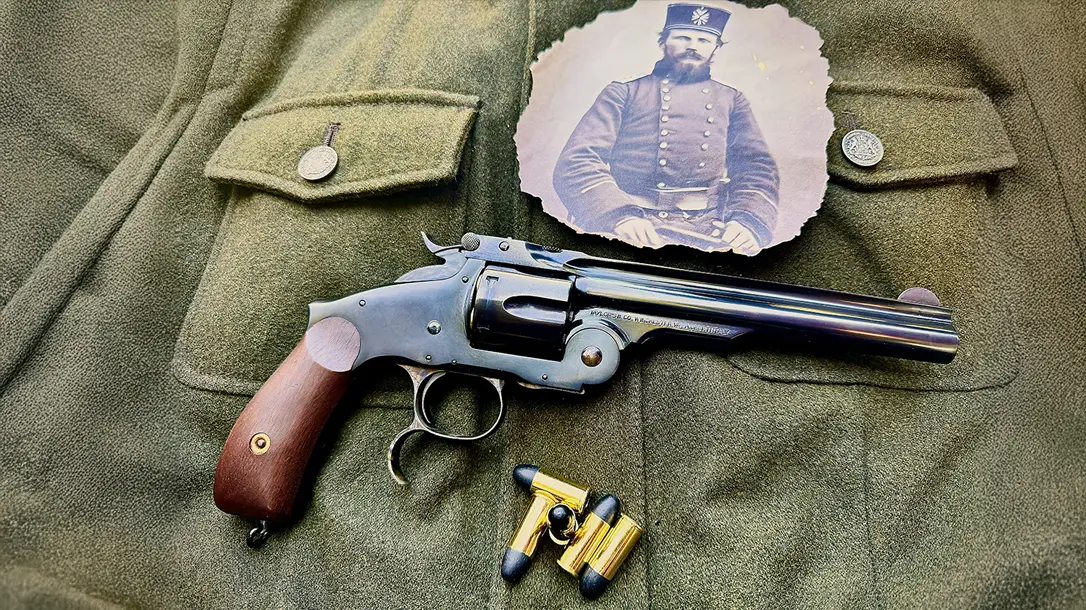Smith & Wesson (S&W) introduced tip-up barrel, fixed metallic cartridge revolvers in 1858. They were known as the Model 1, Model 1-1/2, and Model 2. The design limited them to .22 and .32 rimfire cartridges, but the company wanted to produce a more powerful, larger caliber handgun. S&W secured two patents that enabled them to produce a hinged frame, top-break revolver, which became the Model 3.
Model 3 Russian – A Taylor’s & Co. Modern Replica
The cylinder, secured to the barrel assembly, was attached to the front of the frame by a hinge; when the locking latch built into the top strap was lifted, the barrel could be swung down. This action caused the extractor to push the empty cases from the cylinder chamber and eject them simultaneously. The cylinder could then be loaded with fresh cartridges, and the barrel locked back into place. A .44/100 (American) centerfire cartridge was created for this single-action sixgun, and in August 1870, the factory began to make regular shipments of the Model 3. Demand quickly outstripped production.
Advertisement — Continue Reading Below
The Russian Connection
Although the U.S. Army showed interest in the Model 3 and ordered 1,000 of them, S&W was seeking a larger-volume customer. The Russian military attaché, General Alexander Gorloff, was in the United States, supervising the inspection of rifles being manufactured for his government. An exchange of correspondence began between the General and S&W, which resulted in a contract for 20,000 revolvers.
One big alteration the Russians requested was a change in the .44 caliber cartridge. They wanted one with a cartridge case that was larger in diameter than the bullet. The .44 American was similar to the .22 rimfire and had a case the same diameter as the bullet; this resulted in the bullet having a smaller heel to fit in the case, plus it was outside lubricated. This new .44 Russian cartridge would have an inside-lubricated bullet weighing 246 gr. propelled by 23 gr. of black powder, giving it a velocity of 750 FPS. The cylinder also had “stepped” chambers.
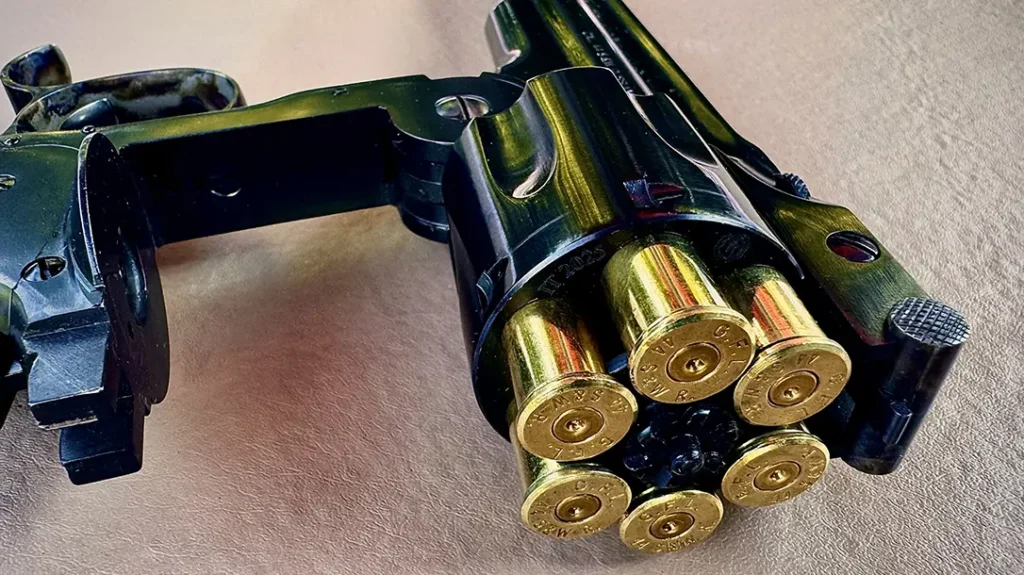
Advertisement — Continue Reading Below
Design Changes
The Model 3 underwent several design changes and improvements, both externally and internally, resulting in the Second Model. Further refinements requested by the Russians included a grip frame backstrap with a “knuckle” at the top, to keep the gun from sliding down into the hand during recoil. They also wanted a hammer with a higher spur, as well as a finger rest incorporated into the bottom of the trigger guard. The final version, known as the Model 3 Russian, Third Model, featured a modification to the extractor/ejection system, resulting in a shorter housing beneath the barrel, and the barrel length was set at 6.5 inches.
This improved model was patented in January 1875 and was subsequently marketed as the Model of 1874 for commercial sales. S&W also sold 30,000 of these new renditions to the Russians, 5,000 to the Turks, and around 1,000 to the Japanese. They were also eagerly purchased in the United States by frontiersmen, lawmen, and outlaws, who had seen the new S&W six-shooters in the hands of U.S. Army cavalrymen.
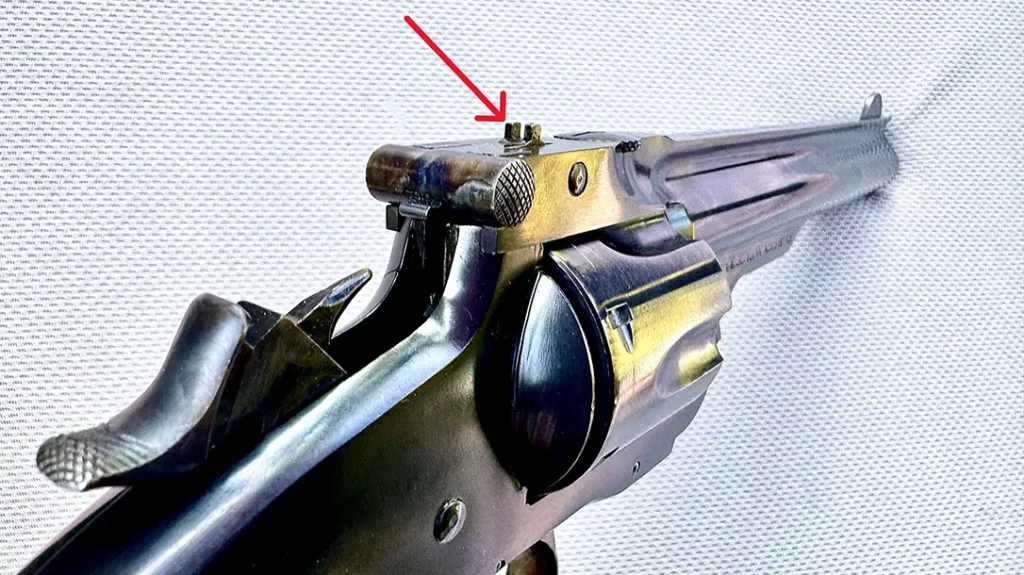
Advertisement — Continue Reading Below
Taylor’s & Co. Replica Model 3 Russian
I recently received notice that Taylor’s & Co. had received a shipment of S&W Model 3 Russian revolvers in .44 Russian. I quickly messaged them requesting a test gun. My Uberti-made sample sixgun arrived shortly thereafter. It came in a blue cardboard box with an owner’s manual; the revolver itself was inside a black nylon padded case with a Velcro closure flap. Taking it out, I took a deep breath as I admired its polished blue finish, with contrasting color case-hardened parts like the hammer, trigger guard, ejector lever, and locking latch. An inspection from muzzle to butt revealed great care and attention to detail, with no flaws detected on the exterior surfaces.
The barrel features an integral rib that extends back from the muzzle, seamlessly blending with the top strap. A half-moon front sight is affixed to the rib by a pin, and the rear locking latch is attached to the top-strap. Two small posts jut up from the latch and serve as a rear sight. A tab projects from the rear of the latch and mates with a notch in the hammer face, serving as a locking point when the hammer is at rest. The barrel, top-strap, and latch assembly fastens to the frame via a large hinge at the front. Unlike later S&W revolvers, the sideplate on the Model 3 Russian is located on the left side of the frame.
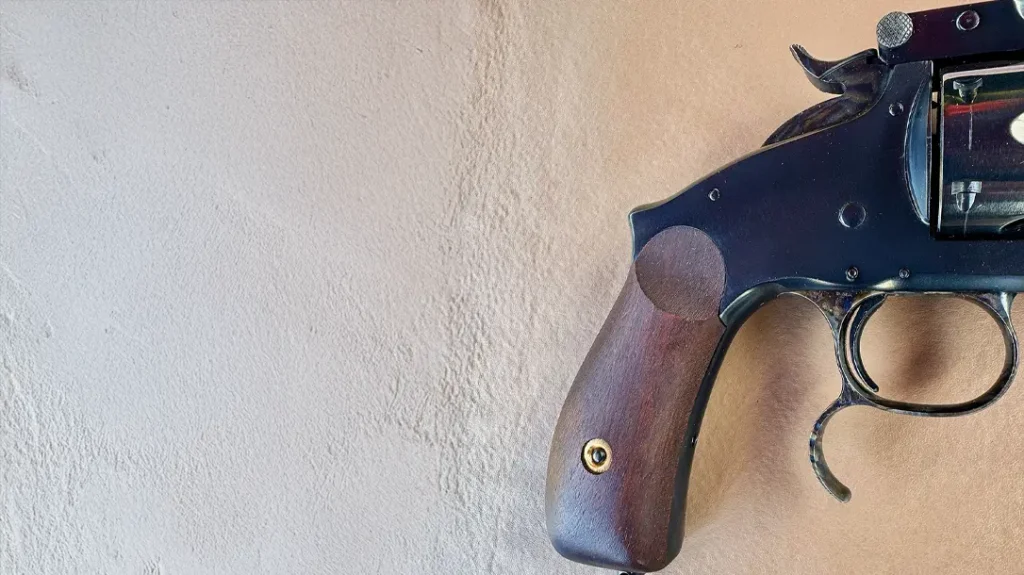
Advertisement — Continue Reading Below
Distinctive Finger Rest
The trigger guard, with its distinctive finger rest, is pinned into the bottom of the frame. Around 0.25 inches in width, the trigger is smooth-faced, and according to my Lyman Trigger Pull Gauge, it has an average pull weight of 5 pounds. 10 oz., with a hint of creep. The hammer spur has a sharp upturn and is checkered. A long, pointy firing pin is integral with the hammer face. It protrudes through the breech face when the hammer is fully at rest, so the chamber under the hammer should be left empty for safety. The hammer must be cocked to the first “click” to open the top latch. There is no half-cock.
To me, the grip frame proportions are reminiscent of the later S&W K-frame revolvers. The two-piece grips are made of walnut and have a finish that appears to be oil-based. On the butt of the grip frame is a small lanyard ring. This is, of course, a single-action revolver, which means the hammer must be manually cocked for each shot. Unlike later S&W wheelguns, the fluted cylinder rotates clockwise. Unlocking the top latch and swinging the barrel/cylinder down raises the ejector rod/star, which extracts the cartridge cases. The rod/star then snaps back into place, ejecting the spent cases.
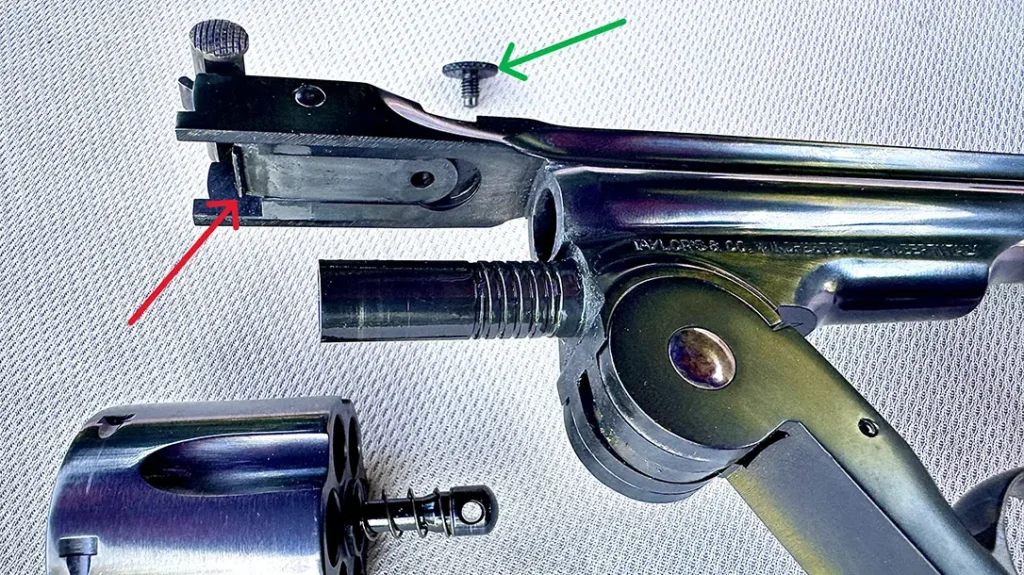
Advertisement — Continue Reading Below
Remove the Cylinder
To remove the cylinder for cleaning, the stop cylinder plate screw on the top strap, just ahead of the locking latch, must be removed. Next, the latch is unlocked and the barrel fully swung down. You can now see the rear edge of the stop cylinder plate, which extends a fraction downward, securing the cylinder in place. Use a thin-blade screwdriver to get under the plate ledge and pull it out approximately 0.25 inches. The cylinder can now be pulled off the base pin bushing. It can be replaced in reverse order.
Preparations and Square Range Work
One of the toughest jobs in this gun test was to obtain .44 Russian ammunition. I was lucky to have a supply of Black Hills Ammunition in this caliber, left over from a previous gun test. It has a 210 gr. flat-point lead (FPL) bullet. Buffalo Arms sent me a sample of their .44 Russian “cowboy” load. It has a 200 gr. Lead, round-nose, flat-point bullet, and comes with 50 rounds, packaged in a reusable plastic, hinged-top box. Hunting Shack Munitions (HSM) provided their Cowboy Action Cartridges, which have a 200-grain. Lead, RNFP bullet. I also received Cowboy Action loads from Fiocchi. Their .44 Russian cartridges have a 247 gr. Lead, round nose bullet, which has a black coating.
I was fortunate to get everything to shoot with the Model 3 Russian before taking it to a Cowboy Action Shooting (CAS) match. At the nearby Range USA facility, I set up on a shooting lane and readied my gear. I sent a large Caldwell Orange Peel bullseye target down to the 10-yard line, set up my Xero C1 Pro chronograph, and obtained velocity measurements on the test ammunition, as well as an idea of the revolver’s point-of-aim/point-of-impact.
Advertisement — Continue Reading Below
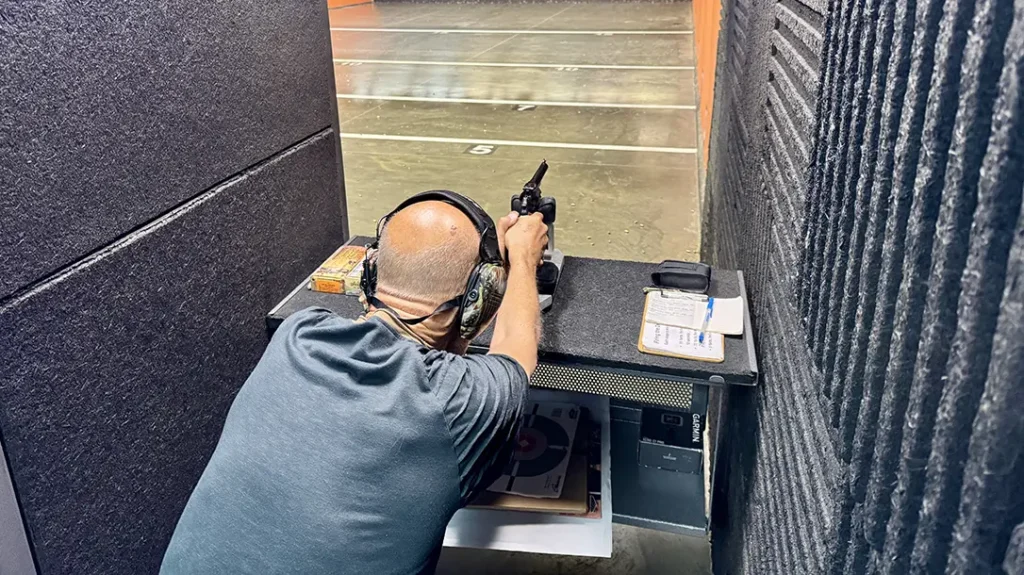
Shooting
Elevation was just fine, but the gun tended to shoot left of center. You can see the bullet velocity data in the performance table. Next, I evaluated the sixgun’s accuracy potential. This was done using smaller Birchwood Casey bullseye targets, set at a distance of 36 feet. Three 5-shot groups from each test load were shot from the bench using a Ransom Steady Rest. My best group measured 0.77 inches and was made using the Fiocchi cartridges. Group averages ranged from 1.56 to 2.25 inches. To get centered impacts, I generally held the front sight at 1:00 o’clock from the red aiming circle.
To get an idea of how the Taylor’s Model 3 Russian would perform at the upcoming CAS match, I sent a Birchwood Casey “cowboy” Splattering Target to the 10-yard line. It’s rectangular and measures 12×18 inches; just about the size of a handgun steel target at a cowboy shoot. I fired 20 shots at the target from a standing, isosceles stance, using a two-handed hold. Shooting as quickly as I could. I would cock the hammer, find the sight picture, and press the trigger. I was pleased to see all my shots were contained within the target’s 7.5×4.5-inch center-mass scoring area. In a couple of days would come the “acid test.”
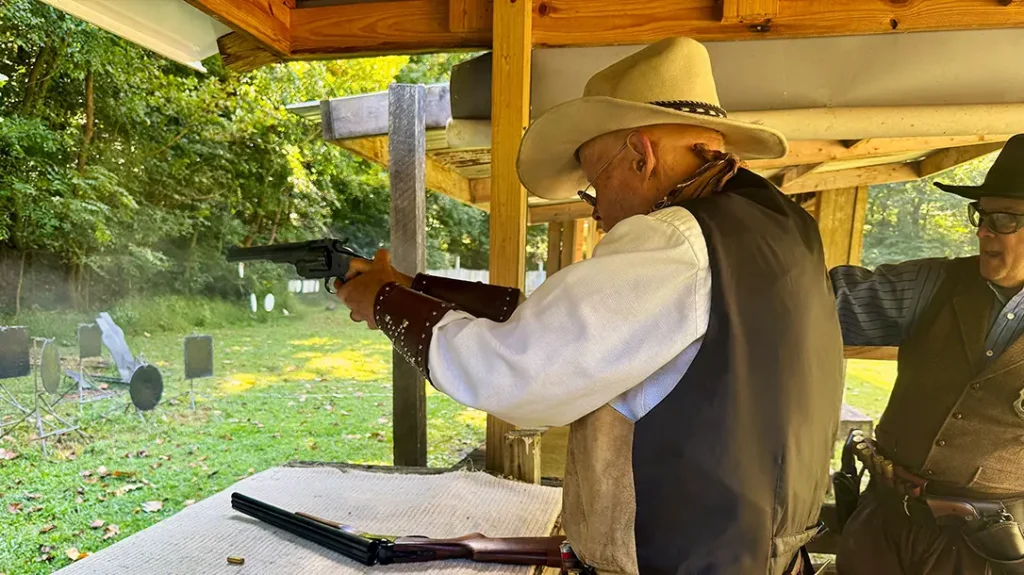
Cowboy Shoot and Conclusions
Sunday at 8:15 AM saw me at the cowboy town range run by the Knob Creek Gunfighters Guild, a Single Action Shooting Society-affiliated club. The match would have six stages, with a break after the first three stages for lunch. As I’m 71 years young, I shot in the Elder Statesman classification. Besides the Model 3 Russian, I used a Single Action Army replica in .44 Special, which also chambers .44 Russian. My rifle was my trusty Rossi Model 92 in .45 Colt, and I had my 12 ga. Stoeger Coach Gun double-barreled. For the match, I was using the Black Hills and Fiocchi .44 Russian cartridges.
LaVista Bill’s performance on the first two stages was found wanting, but as the temperatures warmed up, so did he. I only had one or two misses with the Model 3 Russian; most were with the rifle targets. I had to go a bit slow with the replica S&W due to the tiny rear sight, and to be sure I had the front sight centered properly, and not off to one side or another of the rear sight “posts.” This was my first tine on one of these Model 3 replicas in a long time, so I found that it did not point as naturally for me as my SAA six-shooter. It also has a more muzzle-heavy balance.
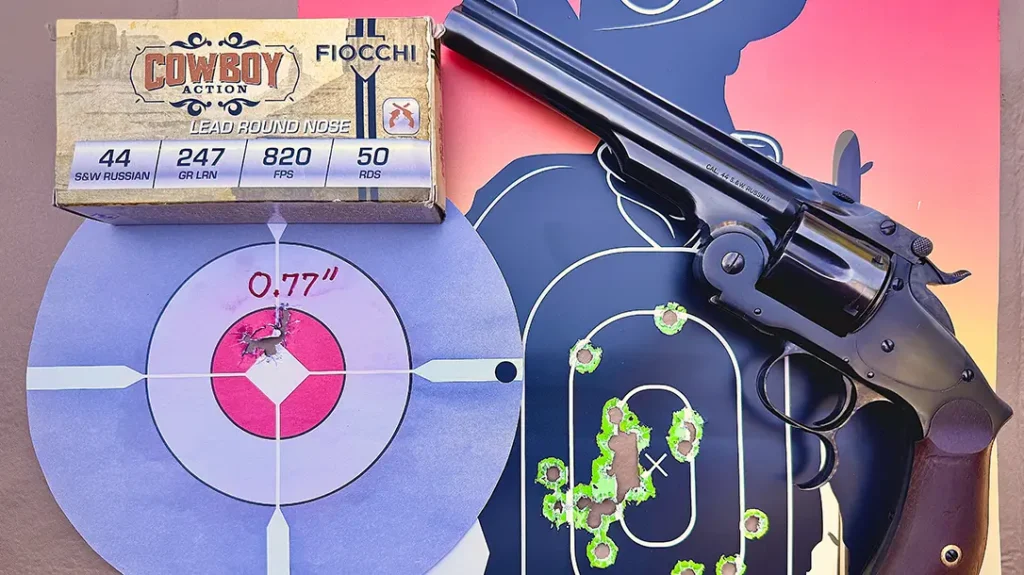
Model 3
As the U.S. Cavalry and its civilian users found, the Model 3 is much faster to break open, empty the spent brass, and reload with fresh cartridges than the Colt Model 1873. The curious trigger guard spur also helped with my two-handed hold and cocking with the support-hand thumb. I really enjoyed shooting this offering from Taylor’s & Co. and managed to take second place in my classification at the cowboy shoot.
For more information, visit Taylor’s & Co.
Taylor’s Model 3 .44 Russian Performance
| Cartridge | Ave. Velocity | Best Group | Average Group |
| Black Hills 210 gr. RNFP | 586 FPS | 1.88” | 2.25” |
| Buffalo Arms 200 gr. RNFP | 565 FPS | 1.31” | 1.56” |
| Fiocchi 247 gr. RN | 670 FPS | 0.77” | 1.00” |
| HSM 200 gr. RNFP | 731 FPS | 1.81” | 2.01” |
NOTE: Bullet weight measured in grains, velocity in feet per second at 15” from the muzzle by a Garmin Xero C1 Pro chronograph, and accuracy in inches for three 5-shot groups at 36 feet.
Taylor’s Model 3 Russian Specifications
| MECHANISM: | Single action revolver |
| CALIBER: | .44 Russian |
| CAPACITY: | 6 cartridges |
| BARREL: | 6.5 in. |
| OA LENGTH: | 12.16 in. |
| EMPTY WEIGHT: | 2.7 lbs. |
| SIGHTS: | Fixed notch on latch rear, round blade front |
| FINISH: | Blue |
| STOCKS: | Two-piece walnut, smooth |
| MSRP: | $ 1,504.21 |
WHY OUR ARTICLES/REVIEWS DO NOT HAVE AFFILIATE LINKS
Affiliate links create a financial incentive for writers to promote certain products, which can lead to biased recommendations. This blurs the line between genuine advice and marketing, reducing trust in the content.


